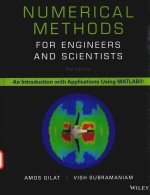

NUMERICAL METHODS FOR ENGINEERS AND SCIENTISTS AN INTRODUCTION WITH APPLICATIONS USING MATLABPDF电子书下载
- 电子书积分:17 积分如何计算积分?
- 作 者:AMOS GILAT
- 出 版 社:WILEY
- 出版年份:2014
- ISBN:9781118554937
- 页数:559 页
Chapter 1 Introduction 1
1.1 Background 1
1.2 Representation of Numbers on a Computer 4
1.3 Errors in Numerical Solutions 10
1.3.1 Round-Off Errors 10
1.3.2 Truncation Errors 13
1.3.3 Total Error 14
1.4 Computers and Programming 15
1.5 Problems 18
Chapter 2 Mathematical Background 23
2.1 Background 23
2.2 Concepts from Pre-Calculus and Calculus 24
2.3 Vectors 28
2.3.1 Operations with Vectors 30
2.4 Matrices and Linear Algebra 32
2.4.1 Operations with Matrices 33
2.4.2 Special Matrices 35
2.4.3 Inverse of a Matrix 36
2.4.4 Properties of Matrices 37
2.4.5 Determinant of a Matrix 37
2.4.6 Cramers Rule and Solution of a System of Simultaneous Linear Equations 38
2.4.7 Norms 40
2.5 Ordinary Differential Equations (ODE) 41
2.6 Functions of Two or More Independent Variables 44
2.6.1 Definition of the Partial Derivative 44
2.6.2 Chain Rule 45
2.6.3 The Jacobian 46
2.7 Taylor Series Expansion of Functions 47
2.7.1 Taylor Series for a Function of One Variable 47
2.7.2 Taylor Series for a Function of Two Variables 49
2.8 Inner Product and Orthogonality 50
2.9 Problems 51
7.5 The Discrete Fourier Series and Discrete Fourier Transform 263
7.6 Complex Discrete Fourier Transform 268
7.7 Power (Energy) Spectrum 271
7.8 Aliasing and Nyquist Frequency 272
7.9 Alternative Forms of the Discrete Fourier Transform 278
7.10 Use of MATLAB Built-In Functions for Calculating Discrete Fourier Transform 278
7.11 Leakage and Windowing 284
7.12 Bandwidth and Filters 286
7.13 The Fast Fourier Transform (FFT) 289
7.14 Problems 298
Chapter 8 Numerical Differentiation 303
8.1 Background 303
8.2 Finite Difference Approximation of the Derivative 305
8.3 Finite Difference Formulas Using Taylor Series Expansion 310
8.3.1 Finite Difference Formulas of First Derivative 310
8.3.2 Finite Difference Formulas for the Second Derivative 315
8.4 Summary of Finite Difference Formulas for Numerical Differentiation 317
8.5 Differentiation Formulas Using Lagrange Polynomials 319
8.6 Differentiation Using Curve Fitting 320
8.7 Use of MATLAB Built-In Functions for Numerical Differentiation 320
8.8 Richardson’s Extrapolation 322
8.9 Error in Numerical Differentiation 325
8.10 Numerical Partial Differentiation 327
8.11 Problems 330
Chapter 9 Numerical Integration 341
9.1 Background 341
9.1.1 Overview ofApproaches in Numerical Integration 342
9.2 Rectangle and Midpoint Methods 344
9.3 Trapezoidal Method 346
9.3.1 Composite Trapezoidal Method 347
9.4 Simpson’s Methods 350
9.4.1 Simpsons 1/3 Method 350
9.4.2 Simpsons 3/8 Method 353
9.5 Gauss Quadrature 355
9.6 Evaluation of Multiple Integrals 360
9.7 Use of MATLAB Built-In Functions for Integration 362
9.8 Estimation of Error in Numerical Integration 364
9.9 Richardson’s Extrapolation 366
9.10 Romberg Integration 369
9.11 Improper Integrals 372
9.11.1 Integrals with Singularities 372
9.11.2 Integrals with Unbounded Limits 373
9.12 Problems 374
Chapter 10 Ordinary Differential Equations:Initial-Value Problems 385
10.1 Background 385
10.2 Euler’s Methods 390
10.2.1 Euler’s Explicit Method 390
10.2.2 Analysis of Truncation Error in Euler’s Explicit Method 394
10.2.3 Eulers Implicit Method 398
10.3 Modified Euler’s Method 401
10.4 Midpoint Method 404
10.5 Runge-Kutta Methods 405
10.5.1 Second-Order Runge-Kutta Methods 406
10.5.2 Third-Order Runge-Kutta Methods 410
10.5.3 Fourth-Order Runge-Kutta Methods 411
10.6 Multistep Methods 417
10.6.1 Adams-Bashforth Method 418
10.6.2 Adams-Moulton Method 419
10.7 Predictor-Corrector Methods 420
10.8 System of First-Order Ordinary Differential Equations 422
10.8.1 Solving a System ofFirst-Order ODEs Using Eulers Explicit Method 424
10.8.2 Solving a System of First-Order ODEs Using Second-Order Runge-Kutta Method (Modified Euler Version) 424
10.8.3 Solving a System ofFirst-Order ODEs Using the Classical Fourth-Order Runge-Kutta Method 431
10.9 Solving a Higher-Order Initial Value Problem 432
10.10 Use of MATLAB Built-In Functions for Solving Initial-Value Problems 437
10.10.1 Solving a Single First-Order ODE Using MATLAB 438
10.10.2 Solving a System of First-Order ODEs Using MATLAB 444
10.11 Local Truncation Error in Second-Order Range-Kutta Method 447
10.12 Step Size for Desired Accuracy 448
10.13 Stability 452
10.14 Stiff Ordinary Differential Equations 454
10.15 Problems 457
Chapter 11 Ordinary Differential Equations:Boundary-Value Problems 471
11.1 Background 471
11.2 The Shooting Method 474
11.3 Finite Difference Method 482
11.4 Use of MATLAB Built-In Functions for Solving Boundary Value Problems 492
11.5 Error and Stability in Numerical Solution of Boundary Value Problems 497
11.6 Problems 499
Appendix A Introductory MA TLAB 509
A.1 Background 509
A.2 Starting with MATLAB 509
A.3 Arrays 514
A.4 Mathematical Operations with Arrays 519
A.5 Script Files 524
A.6 Plotting 526
A.7 User-Defined Functions and Function Files 528
A.8 Anonymous Functions 530
A.9 Function functions 532
A.10 Subfunctions 535
A.11 Programming in MATLAB 537
A.11.1 Relational and Logical Operators 537
A.11.2 Conditional Statements,if-else Structures 538
A.11.3 Loops 541
A.12 Problems 542
Appendix B MATLAB Programs 547
Appendix C Derivation of the Real Discrete Fourier Transform(DFT) 551
C.1 Orthogonality of Sines and Cosines for Discrete Points 551
C.2 Determination of the Real DFT 553
Index 555
- 《朗文大赢家小学英语教程 2》杨枫,(英)阿莫斯(Amos,E.)主编 2006
- 《第一次当经理 新经理的生存手册》(英)朱丽叶-安·阿莫斯(Julie-Ann Amos)著;宋克勤,张彻译 2004
- 《朗文大赢家小学英语教程 1》杨枫,(英)阿莫斯(Amos,E.)主编 2006
- 《朗文大赢家小学英语教程 4》杨枫,(英)阿莫斯(Amos,E.)主编 2006
- 《建成环境的意义 非言语表达方法》(美)阿摩斯·拉普卜特(Amos Rapoport)著;黄兰谷等译 2003
- 《夸美纽斯教育论著选》(捷)夸美纽斯(Comenius,Johan Amos)著;任钟印选编;任宝祥等译 1990
- 《THE SUCCESSFUL STUDENT'S GUIDE TO COLLEGE》JANET A.AMOS 1999
- 《FREEDOM OF EXPRESSION AND THE MEDIA》MERRIS AMOS 2012
- 《PRACTICAL LIQUID CHROMATOGRAPHY》S.G.PERRY R.AMOS P.I.BREWER 2222
- 《AROMATIC FLUORINE COMPOUNDS》ATTILA E.PAVLATH AND AMOS J.LEFFLER 2222
